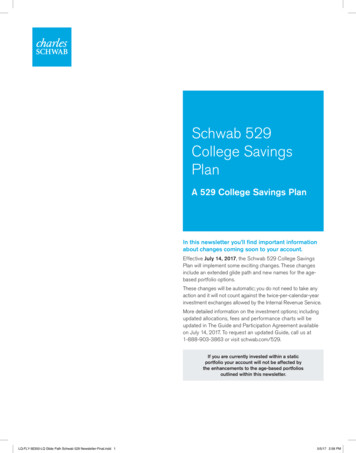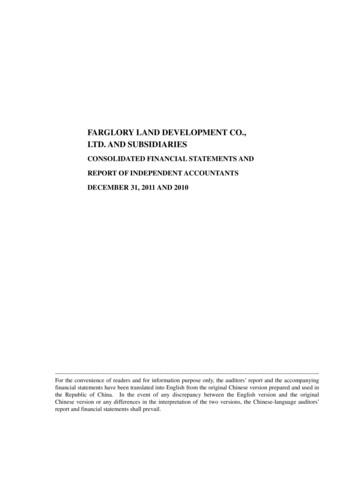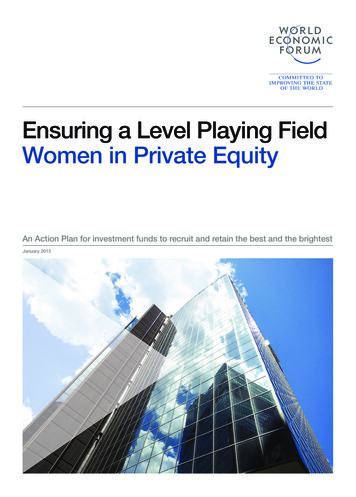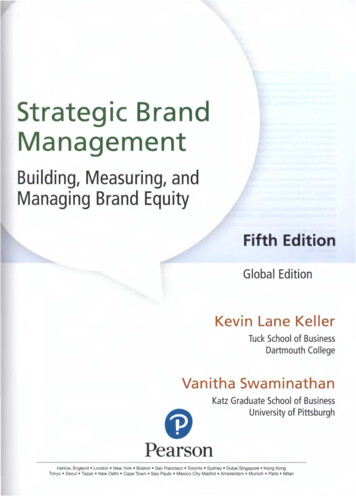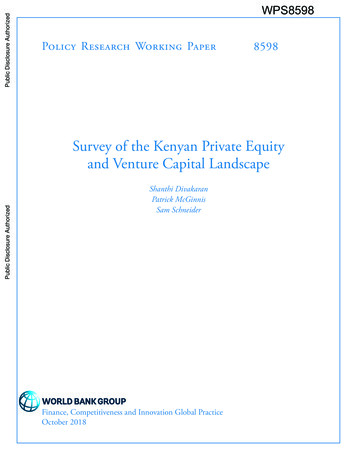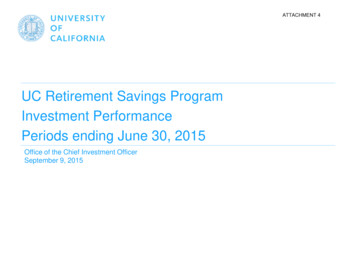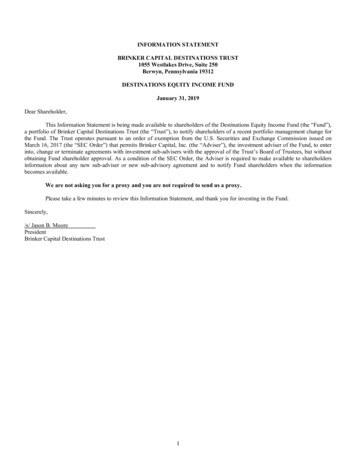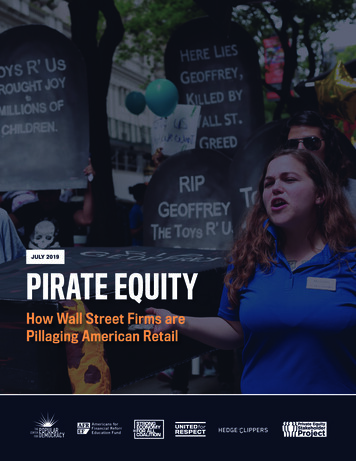
Transcription
JULY 2019PIRATE EQUITYHow Wall Street Firms arePillaging American Retail
ACKNOWLEDGMENTSThis report was researched and written by Jim Baker (Private Equity Stakeholder Project),Maggie Corser (Center for Popular Democracy), and Eli Vitulli (Center for PopularDemocracy). It was edited by Vasudha Desikan and Lily Wang (United for Respect); MarcusStanley, Heather Slavkin, and Patrick Woodall (Americans for Financial Reform); Michael Kink(Hedge Clippers); and Emily Gordon and Connie Razza (Center for Popular Democracy).
EXECUTIVE SUMMARYFor decades, Wall Street firms havebeen driving economic inequalityin our country, threatening workingpeople’s livelihoods, and destabilizinglocal economies. Today, private equity firms owncompanies that employ more than 5.8 millionAmericans.In the last decade alone, private equity firms andhedge funds have made substantial controllinginvestments in over 80 major retail companies,which has drastically impacted the sector. Giventhat private equity-owned companies are twiceas likely to go bankrupt as public companies, itis unsurprising that 10 out of the 14 largest retailchain bankruptcies since 2012 were at privateequity-acquired chains.This original analysis reveals that in the last 10years, a staggering 597,000 people workingat retail companies owned by private equityfirms and hedge funds have lost their jobs. Anestimated additional 728,000 indirect jobs havebeen lost at suppliers and local businesses,meaning Wall Street’s gamble on retail has led tomore than 1.3 million job losses in total.Wall Street firms are poised to impact anadditional one million people working in retail inthe coming years.Risky private equity deals have far-rangingimpacts on working families and local economies:working people face sudden unemploymentand protracted financial hardship; private equityowners often use the bankruptcy process to dumptheir obligations to current and future retirees;pension funds, which make up the largest investorgroup for private equity deals, see poor investmentreturns after private equity-owned retailers gobankrupt; and retail bankruptcies directly reducethe tax bases of states and localities.Wall Street executives exploit gaps in laws andregulations, and lucrative loopholes, to amasshuge profits at the expense of working peopleand local communities. These massive profitspay for luxurious lifestyles for fund managers andtheir families, while workers and their families andcommunities face real hardship.3Photo by Aditya Vyas on Unsplash
KEY FINDINGS1WALL STREET’S GAMBLE ON RETAIL HAS LED TO MORE THAN 1.3MILLION JOB LOSSES: Original analysis reveals that in the last 10 years,597,000 people working at retail companies owned by private equity firmsand hedge funds have lost their jobs. These retail layoffs occurred while thetotal retail industry added over one million additional retail jobs during thesame period.1 Wall Street firms have destroyed eight times as many retail jobs as theyhave created in the past decade.2 This has ripple effects felt far beyond those retailers and their employees.Bankruptcies and store closures at retailers have also spurred layoffs atsuppliers, multiplying job losses. When 100 direct jobs are lost at retailers,122 additional indirect jobs are lost.3 So beyond the 597,000 people whodirectly lost their jobs, an estimated additional 728,000 indirect jobs havebeen lost. That means Wall Street’s gamble on retail has led to more than 1.3 milliontotal job losses.2WALL STREET IS POISED TO IMPACT EVEN MORE WORKING PEOPLE INTHE COMING YEARS: Our analysis shows that over one million retail workers are at risk of losingtheir jobs in the future. These individuals currently working at 80 privateequity and hedge fund-owned retailers face an uncertain future if currenttrends continue.3WALL STREET’S RISKY DEALS HAVE FAR RANGING IMPACTS ONWORKING FAMILIES AND LOCAL ECONOMIES: Beyond the direct and indirect impact on jobs of retail closures, WallStreet owners have been quick to use the bankruptcy process to dumptheir obligations to current and future retirees. In addition, since pension funds make up the largest investor group forprivate equity, retail bankruptcies have negatively impacted pension funds’investment returns, harming retirees. Failures at private equity and hedge fund-owned retailers have alsodirectly reduced the tax bases of states and localities.4
4WALL STREET EXPLOITS A RANGE OF LUCRATIVE TAX LOOPHOLESAND BANKRUPTCY CODE MANIPULATIONS TO BOOST PROFITS ANDAVOID REGULATIONS: Despite being some of the wealthiest people in the country, private equityand hedge fund managers use a number of tax giveaways, including thecarried interest loophole, which allow them to pay taxes at a lower ratethan many working Americans. Wall Street firms also benefit from a revolving door between the financialsector and the government agencies tasked with regulating it.5WALL STREET FIRMS HAVE BEEN KEY DRIVERS OF ECONOMICINEQUALITY: Private equity and hedge fund managers insulate themselves from loss,enjoy lucrative fee structures, and pursue an aggressive tax avoidancestrategy which enables them to reap massive profits. Dozens of private equity executives have become billionaires andthousands more have become extremely wealthy.4 The top 25 hedgefund managers make an average of 850 million per year, and severalfund managers are profiled in this report.5 These same Wall Street actors enrich themselves while lowering workers’wages and benefits. Given one in four retail workers live in or near thepoverty threshold — a proportion that is even higher for Black or Latinxretail workers at 4 in 106 because of discriminatory practices andoccupational segregation — Wall Street-driven wage cuts and job losseshave devastating impacts on families.5
RECOMMENDATIONSThe report findings highlight the urgent need to advance federal policysolutions in 2019 that:61REGULATE private equity firms and hedge funds in order to curb thehigh-risk financial practices that extract wealth from our economy anddestabilize employers.2PROTECT communities and pension funds that provide tax incentivesfor or invest in private equity and hedge funds with transparencyand accountability regulations and the resources needed for activeenforcement of existing policies.3STRENGTHEN the rights of employees when their companies file forbankruptcy, including making it more difficult for creditors to pushcompanies into liquidation instead of reorganization, strengthening theposition of employees as stakeholders in the bankruptcy process, andguaranteeing severance pay and other benefits.4PREVENT private equity and hedge funds from draining value fromcompanies they own through stock buy backs, capital distributions, andfees that divert resources away from the business and jobs.5BUILD public momentum for employee representation at private equityand hedge fund-owned companies for more robust and accountablecorporate governance.6MAKE private equity and hedge fund managers pay a higher share incorporate taxes for reinvestment in communities and the social safety net.
TABLE OF CONTENTS8Introduction10Part I: Private Equity: Wall Street’s Shadow Banking System15Part II: Wall Street’s Role in Retail Bankruptcy and Job Loss21Part III: Why Has Wall Street Acquired So Many Retailers?26Part IV: Ripple Effects: The Impact of Private Equity on LocalEconomies, Cities, and States35Part V: How Did We Get Here? Private Equity Firms andHedge Funds Are Unaccountable to Regulators38A Path Forward39Appendix I: Methodology40Appendix II: Job Loss Data by Retailer7
INTRODUCTIONPrivate equity has long been under firefor exacerbating growing economicinequality at the expense of workingpeople as they reap massive profitsfor executives.7 With big pockets and outsizedpolitical influence, private equity firms haveforced a seismic shift in how Americanbusinesses are run as they reshape companiesand industries to fit their need to extract largeprofits quickly. From retail to healthcare tomanufacturing, private equity firms own, control,and manage an increasingly large number ofcompanies. Prior to the global financial crisis,private equity firms managed around 1 trillionin assets, with investors ranging from publicpension funds to university endowments.8 Today,these firms manage more than 5 trillion in assetsand own almost 8,000 U.S. companies.9 Moreover,today, private equity firms own companies thatemploy more than 5.8 million Americans.10In the last decade, both private equity firms andhedge funds have rapidly expanded into retail,acquiring over 80 major retailers.11 These riskydeals have led to bankruptcies and significantjob losses which have had far-ranging impacts onworking families and local economies. In the lastdecade, Wall Street’s gamble on retail has ledto more than 1.3 million job losses. The stakesare high for the additional one million peoplecurrently working at private equity and hedge8fund-owned retailers. This report underscores theneed to regulate private equity firms and hedgefunds to prevent risky financial practices whilestrengthening the rights of working families andprotecting local communities.Part I of this report explains how private equityfirms and debt financing deals work, includingperverse incentives that encourage excessiverisk-taking by Wall Street executives at theexpense of working people. Part II unveilsnew, original data on the number of retail jobsdestroyed at Wall Street-owned retailers overthe last ten years, as well as estimates of thenumber of additional workers at risk of losingtheir jobs to Wall Street-driven bankruptcies inthe future. Part III traces the financial sector’sdamaging expansion into retail that resulted inthese job losses, as well as the ways in whichprivate equity and hedge fund managers haveexacerbated inequality in the retail sector andbeyond. Part IV moves beyond job losses toexplore the damaging ripple effects the waveof retail bankruptcies is having on state andlocal economies. The final section of the reportexplores how we got here — including the taxloopholes and regulatory weaknesses that haveenabled private equity to explosively expand inrecent years — while underscoring the urgentneed for strengthened regulations.
“After devoting 31 years to a company, I have lost notjust my job but my financial stability. My only optionis to work very physically demanding jobs earningfar less than what I worked so hard to achieve.I deserve better, and so do my coworkers, manyof whom are still unemployed, or were forced ontosocial security at an early age, as a result of havingtheir jobs ruined by the greed of Wall Street hedgefunds and private equity firms.”— DEBBIE MIZEN, FORMER TOYS “R” US WORKER, YOUNGSTOWN, OHIO9
PART 1While Wall Street private equityfirms wield enormous power andinfluence over our economy, theirbusiness practices are not widelyunderstood. Part I will provide an overview ofprivate equity firms, including how they arestructured and how they use debt financingand leveraged buyouts to amass enormousprofits. This section also highlights the perverseincentives shaping their business decisionswhich create a high risk/low reward situation forworking people.While the report primarily refers to private equity,the data analysis also includes hedge funds thatown US retailers. There is a more of a grey areathan a clear divide between private equity andhedge funds. For the purposes of this report, thecritical distinction is not the name of the fund butthe investment strategy that is used. This reportexamines funds that take control of companiesand use their control rights to drain value fromthe companies in ways that negatively affectthe sustainability of the firm and its relationshipto workers and communities. Taking control ofcompanies is an investment strategy typicallyassociated with private equity firms, but nothingstops hedge funds from owning companies andmany have pursued this strategy. However, thisreport does not address investment strategies thatinvolve short-term market speculation that do notinvolve control of companies, which is a strategymore typically associated with hedge funds.PRIVATE EQUITY: WALL STREET’SSHADOW BANKING SYSTEMPrivate equity firms are Wall Street investmentcompanies that raise money from pensionfunds, endowments, hedge funds, and wealthy10individuals in order to acquire companies. Privateequity managers often claim they will quickly fixthese companies and make them more profitable.Then, the private equity firms will sell the newlyprofitable company or take it public on the stockexchange. They typically plan to resell a companywithin five years and promise high returns toinvestors in the process.12In practice, these Wall Street firms makesweeping changes to cut costs and boostprofits, including pay freezes, layoffs, andstore closures.13 Private equity firms often takecontrol of boards and appoint new leadershipat companies. One study found that nearly 70percent of CEOs are replaced at some pointduring private equity ownership (typically a 3 to 5year ownership window);14 whereas average CEOtenure in the US is seven years.15In the retail industry, both private equity firms andhedge funds have made substantial controllinginvestments in major companies over the lastseveral years. Private equity and hedge fundowned retailers employ more than 1 million ofthe 15.8 million retail workers nationwide.16 Awave of high-profile retail bankruptcies in thelast few years — including household nameslike RadioShack, Toys “R” Us, Sports Authority,Payless ShoeSource, Sears, and Kmart — haveimpacted retailers owned by Wall Street.17THE RISE OF “DEBT FINANCING”AND LEVERAGED BUYOUTSPrivate equity has seized retail targets throughrisky investment deals called leveraged buyouts(LBOs) that saddle retailers with high debt andcan instigate sweeping changes, including paycuts and store closures.18 The first part of a
DEBBIE MIZENDEBBIE MIZEN lives in Youngstown, Ohio, and began working at Toys “R”Us in 1987. She was a single mother when she started working and was ableto care for her three children on her modest salary. Debbie was an assistantmanager for the last 12 years of her career, although she knew she wasearning less than male supervisors in the same position. In June 2018, shelost a job she loved when Toys “R” Us liquidated and closed over 800 storesacross the country. Debbie found out that her store was closing on sameday as her mother’s funeral and was devastated. Since her store closed, shehas faced unemployment. When her unemployment checks ran out, she hadto take a job in a grocery store collecting grocery deliveries for customerswhile earning half of what she did at Toys “R” Us. She is turning 67 this year.YO U N G S T OW N , O H I Oleveraged buyout (LBO) is not unlike the processof buying a home. When a family buys a housethey make a downpayment and use mortgagefinancing to pay back the home loan over time.However, the critical LBO difference is that whena private equity firm acquires a company, itmakes a downpayment with money from investorsand then requires the target company to takeout the loans needed to finance the deal. Thatmeans the companies, not the private equity firms,are responsible for repaying the debt. The onlymoney that private equity firms have at stake istheir initial down payment equity investment (thisis often only a third or less of the total cost toacquire the company).19 Most of this investmentcomes from limited partners who are the outsideinvestors to the private equity fund. It is frequentlythe case that the general partners who actuallycontrol the private equity firm only contribute 1to 2 percent of the equity that’s required for theleveraged buyout.20HIGH RISK/LOW REWARD FORWORKING PEOPLELeveraged buyouts are structured so that privateequity firms can reap the biggest benefits withlimited personal risk. This deal structure offersprivate equity managers perverse incentives thatencourage short-termism and excessive risktaking, generally at the expense of the employeesof acquired portfolio companies.21 While publiccompanies usually get about 30% of their capitalfrom debt, private equity-owned businessesoperate with about 70% debt.22 The use of largeamounts of debt in private equity acquisitions hasbeen a major driver of the growth in excessivecorporate debt, which regulators have cited as adangerous amplifier of the next recession.23 TheInternational Monetary Fund (IMF) recently foundthat over half of leveraged lending in 2018 wasacquisition-related.24Private equity firms contend that these unusuallyhigh debts will impose discipline on managersand force accountability on companies thatwill benefit from private equity managers’ closemonitoring and oversight.25 However, this debtarrangement is actually a low-risk and highreward setup for these Wall Street firms. Itincentivizes excessive risk-taking by privateequity managers at the expense of the acquiredcompany. If the private equity firm drives acompany into bankruptcy, the loss for the privateequity firm is limited; it is the company andits workers who pay the price.26 Because thecompany — rather than the private equity firm— is actually on the hook for the debt, workers,vendors, and institutional investors are left trying11
to negotiate over whatever remains after thecompany covers its debt payments.27Despite these serious risks, private equity hasthrived for decades thanks to lax regulation andtax loopholes that favor its business model.28Private equity managers have deployed theirmassive wealth to exert considerable politicalinfluence to maintain these unfair advantages.29They benefit from a lack of transparency aroundtheir business operations and fee structures, aswell as a revolving door between the governmentand private equity firms. Private equity managershave secured powerful regulatory roles within thegovernment and later left those roles to return tothe financial sector. (For instance, immediatelybefore becoming Commerce Secretary, WilburRoss previously spent 17 years at WL Ross &Co, a private equity fund he founded.)30 Withoutsufficient regulation and government oversight,private equity firms have been emboldened totake excessive risks. These risky deals threatenthe stability of our economy, compound inequality,and gamble with the livelihoods of millions ofworking people.WALL STREET IS DRIVING THE RECENTWAVE OF RETAIL BANKRUPTCIESPrivate equity’s expansion into retail has beenfollowed by wide scale job losses that havedevastated working families and destabilized oureconomy.31 There have been a growing numberof high-profile retail bankruptcies and storeclosures. In the past five years, dozens of majorretailers have gone bankrupt.32 While many point12to the rise of e-commerce and competition fromAmazon hurting the retail industry, this simplisticanalysis overlooks the destabilizing impact ofWall Street takeovers of retail brands. EileenAppelbaum, from the Center for Economic andPolicy Research, and Rosemary Batt, a professorat Cornell University who studies managementand employment relations, cite findings that thehigh amounts of debt in a typical private equitydeal lead to higher rates of bankruptcy.33 Acrossall sectors, private equity-owned companiesare twice as likely to go bankrupt as publiccompanies.34Private equity firms owned a considerablemajority of retailers that have gone intobankruptcy. Ten out of the 14 (or 71 percent) ofthe largest retail chain bankruptcies since 2012were at private equity-acquired chains. Amongthe retailers that filed for Chapter 11 bankruptcyin 2016 and 2017, two-thirds were backed byprivate equity.35
2019 STORE CLOSURESIn just the first three months of 2019, 33 retailers haveannounced 6,683 store closures.36The vast majority — 70% — of these 2019 store closuresare by retailers owned by private equity firms.37In total, private equity-owned retailers are set to shutter4,680 stores at name brands like Payless Shoes, Sears,K-Mart, J. Crew, Shopko, and Charlotte Russe.33RETAILERS6,683CLOSURES70%OWNED BY PRIVATE EQUITY FIRMS13
MARY OSMANB OA R D M A N , O H“I don’t know what my future will be like. I can’tfind another job at my age — no one will hire me.I dedicated my life to Toys ‘R’ Us and today I’mleft with nothing. This is why I’m fighting to makethings right, by changing the laws that allowprivate equity companies to get rich by destroyingthe livelihoods of hardworking people like me andmy Toys ‘R’ Us family.”MARY OSMAN worked at Toys “R” Us in Boardman, Ohio, for 24 years where she was a cashier. In2016 she lost her benefits and continued working part-time at Toys “R” Us, relying on her husband forhealth insurance. She lost her job at Toys “R” Us when the company liquidated in 2018 and closed allof its stores — over 800 — across the country. Mary had planned to work at Toys “R” Us for three yearsbefore retiring with her husband. Since her store closed, Mary has been unemployed. Her husband hascontinued working to support both of them. Mary is also relying on social security to make ends meet.Prior to the Toys “R” Us bankruptcy Mary was looking forward to retirement in a few years. She insteadfinds herself at the bottom of the career ladder, competing with much younger applicants for incrediblylabor-intensive positions.14
PART IIWALL STREET IS A JOB KILLERPrivate equity firms have a demonstratedrecord of destroying jobs while claimingto create economic growth.38 Privateequity-owned companies cut jobs andlay off employees in order to increase cashflow or shut down entirely due to crushing debtloads. A National Bureau of Economic Researchanalysis of over 3,000 private equity acquisitionsfound that retail companies acquired by privateequity experienced a 12 percent drop inemployment over the subsequent five years.39WALL STREET’S ROLE IN RETAILBANKRUPTCY AND JOB LOSSOur original analysis to measure the impact ofWall Street on retail bankruptcy and job lossfinds that a staggering 597,000 people workingat private equity and hedge fund-owned retailershave lost their jobs in the last 10 years after theirWall Street-managed retailers went bankrupt orliquidated.40 These retail layoffs are especiallytroubling because they occurred while the retailindustry added over one million additional jobsduring the same period.41 Over the same period,private equity and hedge fund-owned retailersadded only around 76,000 jobs—creating onlyone job for every eight jobs that were eliminated— meaning that Wall Street cost the retail sectorover half a million (521,000) in net job losses.These job losses spanned over 25 retailers,including household names like Sears, Toys“R” Us, Payless, Sports Authority, Claire’s, andRadioShack.INDIRECT JOB LOSS: EFFECTSOF RETAIL BANKRUPTCIES FELTBEYOND RETAILERSThese job losses devastate local economies andultimately ripple throughout the national economyas suppliers and local small businesses feelthe downstream effects. Not only have privateequity and hedge fund-owned retailers laid offhundreds of thousands of workers, the WallStreet-driven retail bankruptcies also have effectsthat are felt far beyond those retailers and theirformer employees. Businesses and their workers,including in the retail sector, not only providedirect jobs but also have multiplier effects onindirect jobs; in other words, their economicactivity supports workers in other industries,such as those who manufacture and deliver theproducts sold at retailers and businesses whereretail employees spend their income, like grocerystores or gas stations.A STAGGERING 597,000PEOPLE WORKING AT WALLSTREET-OWNED RETAILERSHAVE LOST THEIR JOBS INTHE LAST 10 YEARS.15
Private equity-owned retailers’ suppliers andtheir employees suffer when the retailers gobankrupt, close stores, or shut down completely.For example in July 2018, just months after Toys“R” Us shut down, Mattel, the maker of Barbie andHot Wheels, announced it was laying off 2,200workers after its sales dropped by 14 percent.42Then, in October 2018, toymaker Hasbro — whichproduces Play Doh, Transformers, and My LittlePony toys — announced it would lay off up to 10%of its employees. Hasbro’s sales fell 12% in thethird quarter 2018, a drop the company attributedprimarily to the loss of Toys “R” Us.43A January 2019 study by the Economic PolicyInstitute noted that for every 100 direct jobslost at retailers, approximately 122 additionalindirect jobs are lost.44 Over the past decade, the Phillip Pessar, FlickrTOYS “R” US BANKRUPTEDBY WALL STREETIn 2005, Toys “R” Us was purchased in a 6.6billion leveraged buyout by private equity firmsBain Capital, KKR, and Vornado Realty Trust.Toys “R” Us sales totaled 11.2 billion in the12 months before the leveraged buyout. WhileToys “R” Us’ revenues remained steady overthe next 13 years — 11.1 billion in sales in 201716597,000 documented direct retail job losseshave caused an estimated additional 728,000indirect-job losses, meaning Wall Street’sgamble in retail has likely cost more than 1.3million total job losses.WOMEN AND PEOPLE OF COLORHARDEST HIT BY JOB LOSSESWall Street has eliminated jobs across the retailindustry but layoffs were most concentrated inthe clothing, general merchandise, and grocerysubsectors. Given the workforce demographicsof those subsectors and the dynamics ofthe broader economy, these job lossesdisproportionately impact a diverse workforcewith large numbers of women and people ofcolor. For instance, more than three-quarters— the retailer was saddled with debt it couldn’trepay.45 By 2007, 97% of the company’s operatingincome was consumed by interest, which leftthe company unable to upgrade technology orevolve its business model.46 The heavy debtload incurred by Toys “R” Us, combined with itsinability to invest money to compete with retailerslike Amazon, eventually led Toy “R” Us to file forbankruptcy in 2018. The company liquidated inJune of 2018 and closed their remaining 800stores. Over 33,000 employees of the companylost their jobs and their severance payments inbankruptcy court.47 The PE companies controllingthe Toys “R” Us bankruptcy refused buyers thatwould have saved thousands of jobs and insteadchose liquidation to maximize the financialextraction.48 The private equity firms that ownedToys “R” Us collected more than 470 millionin fees and interest from the retailer over theownership period. With the support of Unitedfor Respect, Toys “R” Us employees launched anational campaign that successfully pressed KKRand Bain to create a 20 million hardship fund forthese impacted families.49
1 in 4retail workers live below or nearthe poverty threshold56SAD’E DAVISVA N N U YS , C A2 in 5Black (43%) and Latinx (42%) retailworkers live in or near poverty(76%) of workers in the retail clothing sector arewomen, and 43% are Black, Asian, or Latinx.50In the general merchandise sector, nearly half ofworkers (46%) are Black, Asian, or Latinx, and60% are women.51SAD’E DAVIS lived across the street fromher Toys “R” Us in Van Nuys, California,and was a loyal customer for many yearsbefore getting hired as an associate. As asingle mother of two daughters who had towork multiple jobs to get by, Sad’e felt likeToys “R” Us was a home away from home.Her coworkers were like a second family.However, after four years with the company,Sad’e was laid off during liquidation. Shewas forced to survive with the incomefrom her remaining job at Burlington CoatFactory, while supporting her two daughtersand taking care of her grandmother anddisabled mother. She now lives in uncertainty— knowing her job could be stolen by WallStreet greed at any moment.These job losses are especially devastating forpeople working in retail because they alreadyface high rates of poverty and income volatility.Retail employers often provide poor quality jobswith low pay and no benefits, stagnant wages,high rates of underemployment (despite manyworkers wanting full-time hours), and unstableschedules that fluctuate week to week.52 As aresult, one out of four retail workers live belowor near the poverty level.53 Retail workers ofcolor face high rates of occupational segregationand are concentrated in the retail jobs and subsectors with the lowest pay and limited mobility(such as cashier positions in apparel).54 Facedwith poor job quality and widespread racialdiscrimination, very high numbers of retail17
“It’s definitely hard to work in retail and raise a family on minimumwage. It’s even harder to wake up one day without a job. My girlshave had to sit back and endure watching me juggling 5 to 6 jobsat a time. So I’m fighting for them. From the bottom of my heart Ipray this cycle of failing retail jobs comes to an end.”— SAD’E DAVIS, FORMER TOYS “R” US WORKER, VAN NUYS, CAworkers of color — two out of five of Black (43%)and Latinx (42%) — live in or near poverty.55Half of retail workers experience incomevolatility from week to week due to unpredictableschedules.57 This income volatility makes savingdifficult and decreases the likelihood thatpeople will have a cushion to weather suddenunemployment. Since 40% of Americans cannotcover a 400 emergency expense, privateequity-driven job losses add significant financialprecariousness for impacted workers.58 Finally,65% of people working in retail have a childin their home, which brings added urgency tosecuring reliable income.59The effects of unemployment can be significantand long-lasting, especially for Black and Latinxworkers who have a harder time reboundingand face employment discrimination in the jobsearch process.60 People who lose their jobsafter private equity and hedge fund acquisitionsmust navigate a labor market rife with racialdisparities. Black unemployment is consistentlytwice the rate of white unemployment due to ahost of discriminatory systems and practices byhiring managers. Biased decisions and systemicbarriers negatively impact the job prospectsof applicants of color.61 Black workers aredispropor
the data analysis also includes hedge funds that own US retailers. There is a more of a grey area than a clear divide between private equity and hedge funds. For the purposes of this report, the critical distinction is not the name of the fund but the investment strategy that is used.

